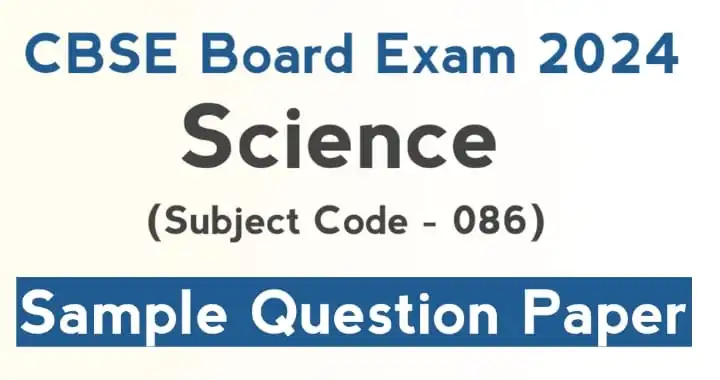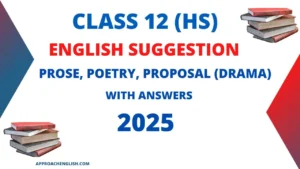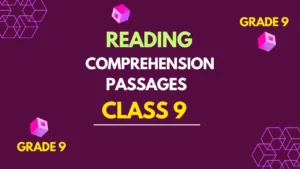The science Sample Paper for Class 10 2023-2024 has been announced on the Official Website of CBSE recently. To have a clear concept of the Questions Types, Marking schemes, and Sample answers, students can download CBSE Science Sample Paper for Class 10 2023-2024.
CBSE Science Sample Paper for Class 10 2023-2024 Question Types
i CBSE Science Sample Paper for Class 10 2023-2024 question paper consists of 39 questions in 5 sections.
ii. All questions are compulsory. However, an internal choice is provided in some questions. A student is expected to attempt only one of these questions.
iii. Section A consists of 20 objective-type questions carrying 1 mark each.
iv. Section B consists of 6 Very Short questions carrying 02 marks each. Answers to these questions should be in the range of 30 to 50 words.
v. Section C consists of 7 Short Answer type questions carrying 03 marks each. Answers to these
questions should be in the range of 50 to 80 words.
vi. Section D consists of 3 Long Answer type questions carrying 05 marks each. Answer to these
questions should be in the range of 80 to 120 words.
vii. Section E consists of 3 source-based/case-based units of assessment of 04 marks each with sub-parts
Science Sample Paper for Class 10 2023-24, CBSE
Sample Question Paper
2023-24 Class X
Science (Subject Code – 086)
Max. Marks: 80 Time Allowed: 3 hours
1.

Identify the product which represents the solid state in the above reaction.
a) Barium chloride
b) Barium sulphate
c) Sodium chloride
d) Sodium sulphate
2. The colour of the solution observed after 30 minutes of placing zinc metal to copper sulphate solution is
a) Blue
b) Colourless
c) Dirty green
d) Reddish Brown
3. Mild non-corrosive basic salt is
a) Ca (OH)2
b) NaCl
c) NaOH
d) NaHCO3
4. On adding dilute sulphuric acid to a test tube containing a metal ‘X’, a colourless gas is produced when a burning match stick is brought near it. Which of the following correctly represents metal ‘X’?
a) Sodium
b) Sulphur
c) Copper
d) Silver
5. Which one of the following correctly represents Sodium oxide?

6. An element with atomic number will form a basic oxide.
a) 7 (2,5)
b) 17 (2,8,7)
c) 14 (2,8,4)
d) 11 (2,8,1)
7. An element ‘M’ has 50% of the electrons filled in the 3rd shell as in the 2nd shell. The atomic number of ‘M’ is:
a) 10
b) 12
c) 14
d) 18
8. Generally food is broken and absorbed within the body of organisms. In which of the following organisms is it done outside the body?
a) Amoeba
b) Mushroom
c) Paramoecium
d) Lice
9. Receptors are usually located in sense organs. Gustatory receptors are present in
a) tongue
b) nose
c) eye
d) ear
10. A farmer wants to grow banana plants genetically similar enough to the plants already available in his field. Which one of the following methods would you suggest for this purpose?
a) Regeneration
b) Budding
c) Vegetative propagation
d) Sexual reproduction
11. Height of a plant is regulated by:
a) DNA which is directly influenced by growth hormone.
b) Genes which regulate the proteins directly.
c) Growth hormones under the influence of the enzymes coded by a gene.
d) Growth hormones directly under the influence a gene.
12. A sportsman, after a long break of his routine exercise, suffered muscular cramps during a heavy exercise session. This happened due to:
a) lack of carbon dioxide and formation of pyruvate.
b) presence of oxygen and formation of ethanol.
c) lack of oxygen and formation of lactic acid.
d) lack of oxygen and formation of carbon dioxide.
13. An object is placed in front of a convex mirror. Its image is formed:
a) at a distance equal to the object distance in front of the mirror.
b) at twice the distance of the object in front of the mirror.
c) half the distance of the object in front of the mirror.
d) behind the mirror and it’s position varies according to the object distance.
14. When light enters the atmosphere it strikes on extremely fine particles, which deflect the rays of light in all possible directions, This is due to –
a) reflection of light
b) atmospheric refraction
c) scattering of light
d) dispersion of light
15. In 1987, an agreement was formulated by the United Nations Environment Programme (UNEP) to freeze the production of “X” to prevent depletion of “Y”. “X” and “Y” respectively referred here are:
a) Ozone; CFCs
b) CFCs; rays UV
c) CFCs; Ozone
d) UV rays; Diatomic oxygen
16. Which of the following features relates to biodegradable substances?
a) Broken down by biological processes
b) Remain inert
c) Persist in environment for long time
d) May harm the ecosystem
Questions No. 17 to 20 consist of two statements – Assertion (A) and Reason (R). Answer these questions by selecting the appropriate option given below:
a) Both A and R are true, and R is the correct explanation of A.
b) Both A and R are true, and R is not the correct explanation of A.
c) A is true but R is false.
d) A is false but R is true.
17. Assertion: Rusting of Iron is endothermic in nature.
Reason: As the reaction is slow, the release of heat is barely evident.
18. Assertion: Probability of survival of an organism produced through sexual reproduction is more than that of organism produced through asexual mode.
Reason: Variations provide advantages to individuals for survival.
19. Assertion: A compass needle is placed near a current carrying wire. The deflection of the compass needle decreases when the magnitude of the current in the wire is increased.
Reason: The strength of a magnetic field at a point near the conductor increases on increasing the current.
20. Assertion: Biodegradable substances result in the formation of compost and natural replenishment.
Reason: It is due to breakdown of complex inorganic substances into simple organic substances.
Section-B
Questions No. 21 to 26 are very short answer questions
21. Dil. HCl is added to Zn granules.” How will you prove that chemical change has taken place here? Support your response with two arguments.
22. State the post-fertilisation changes that lead to fruit formation in plants.
23. What is the purpose of making urine in the human body? Name the organs that stores and releases the urine.
OR
Why do arteries have thick and elastic walls whereas veins have valves?
24. The refractive indices of three media are given below:
| Medium | Refractive Index |
| A | 1.6 |
| B | 1.8 |
| C | 1.5 |
A ray of light is travelling from A to B and another ray is travelling from B to C.
(a) In which of the two cases the refracted ray bends towards the normal?
(b) In which case does the speed of light increase in the second medium? Give reasons for your answer.
25. A piece of wire of resistance R is cut into three equal parts. These parts are then connected in parallel. If the equivalent resistance of this parallel combination is R1, what is the value of the ratio R1 : R?
OR
Refer to the image below and state how the magnetic field pattern indicates regions where the magnetic field is stronger outside the magnet? What happens to the magnetic field when the current in the circuit is reversed?

26. Study the food chain given below and answer the questions that follow:

a) If the amount of energy available at the third trophic level is 100 joules, then how much energy will be available at the producer level? Justify your answer.
b) Is it possible to have 2 more trophic levels in this food chain just before the fourth trophic level? Justify your answer.
Section-C
Questions No. 27 to 33 are short answer questions
27. The given reaction shows one of the processes to extract the metals like Iron and Manganese.
MnO₂ (s) + Al(s) → Mn(l) + Al₂O₃(s) + Heat
a) Give reason why the above reaction is known as a thermite reaction.
b) Identify the substance oxidised and reduced in the above reaction.
c) Give a reason why Aluminium is preferably used in thermite reactions.
28. An element ‘M’ with electronic configuration 2 8 3 combines separately with Cl-, SO4-2 anions. Write the chemical formulae of the compounds formed. Predict with the suitable reason the nature of the bond formed by element ‘M’ in general. How will the electrical conductivity of the compounds formed vary with respect to ‘M’?
OR
A reddish-brown metal ‘X’, when heated in air, gives a black compound ‘Y’, which when heated in presence of H₂ gas gives ‘X’ back. ‘X’ is refined by the process of electrolysis; this refined form of ‘X’ is used in electrical wiring.
Identify ‘X’ and ‘Y’. Draw a well-labeled diagram to represent the process of refining ‘X’.
29. We are advised to take iodised salt in our diet by doctors. Justify it’s importance in our body.
30. What is the probability of a girl or a boy being born in a family? Justify your answer.
31. (i) Explain why the refractive index of any material with respect to air is always greater 1.
(ii) In the figure below a light ray travels from air into the semi-circular plastic block. Give a reason why the ray does not deviate at the semi-circular boundary of the plastic block.

(iii) Complete the ray diagram of the above scenario when the light ray comes out of the plastic block from the top flat end.
32. (i)State the law that explains the heating effect of current with respect to the measurable properties in an electrical circuit.
(ii) List the factors on which the resistance of a conductor depends.
33. Anannya responded to the question: Why do electrical appliances with metallic bodies are connected to the mains through a three pin plug, whereas an electric bulb can be connected with a two pin plug?
She wrote: Three pin connections reduce heating of connecting wires.
(i) Is her answer correct or incorrect? Justify.
(ii) What is the function of a fuse in a domestic circuit?
Section-D
Questions No. 34 to 36 are long answer questions.
34. a) Rehmat classified the reaction between Methane and Chlorine in presence of sunlight as a substitution reaction. Support Rehmat’s view with suitable justification and illustrate the reaction with the help of a balanced chemical equation.
b) Chlorine gas was prepared using electrolysis of brine solution. Write the chemical equation to represent the change. Identify the other products formed in the process and give one application of each.
OR
Raina while doing certain reactions observed that heating of substance ‘X’ with vinegar like smell with a substance ‘Y’ (which is used as an industrial solvent) in presence of conc. Sulphuric acid on a water bath gives a sweet-smelling liquid ‘Z’ having molecular formula C4H8O2. When heated with caustic soda (NaOH), ‘Z’ gives back the sodium salt of and the compound ‘Y’.
Identify ‘X’, ‘Y’, and ‘Z’. Illustrate the changes with the help of suitable chemical equations. 5
35. Given below are certain situations. Analyze and describe its possible impact on a person:
a) Testes of a male boy are not able to descend into scrotum during his embryonic development.
b) Vas deferens of a man is plugged.
c) Prostate and seminal vesicles are not functional.
d) Egg is not fertilised in a human female.
e) Placenta does not attach to the uterus optimally.
OR
a) A doctor has advised Sameer to reduce sugar intake in his diet and do regular exercise after checking his blood test reports. Which disease do you think Sameer is suffering from? Name the hormone responsible for this disease and the organ producing the hormone.
b) Which hormone is present in the areas of rapid cell division in a plant and which hormone inhibits the growth?
CBSE Science Sample Paper for Class 10 2024 Full Download
Download the full CBSE Science Sample Paper for Class 10 2024 along with Answers Paper, and Marking Scheme.







